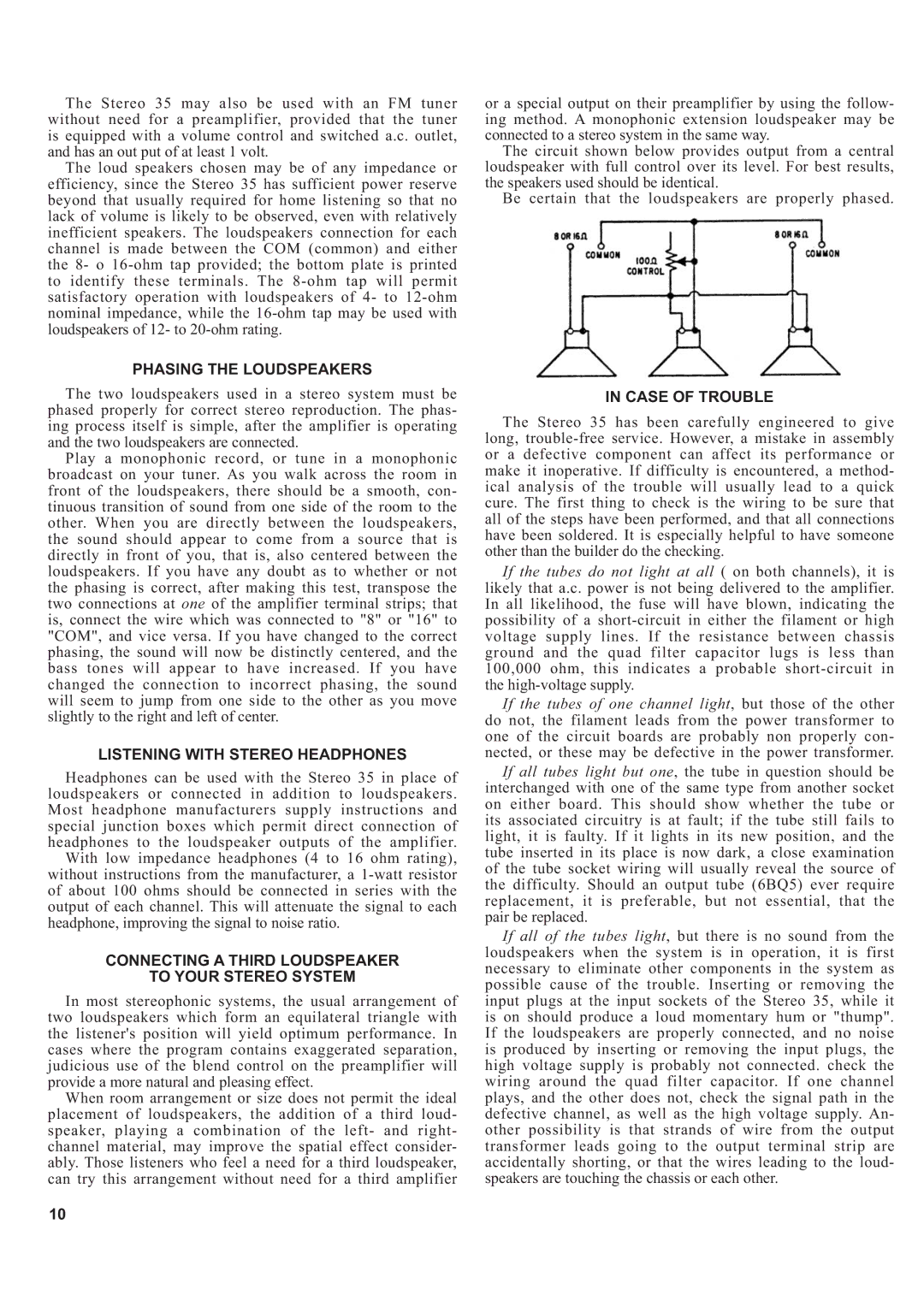
The Stereo 35 may also be used with an FM tuner without need for a preamplifier, provided that the tuner is equipped with a volume control and switched a.c. outlet, and has an out put of at least 1 volt.
The loud speakers chosen may be of any impedance or efficiency, since the Stereo 35 has sufficient power reserve beyond that usually required for home listening so that no lack of volume is likely to be observed, even with relatively inefficient speakers. The loudspeakers connection for each channel is made between the COM (common) and either the 8- o
PHASING THE LOUDSPEAKERS
The two loudspeakers used in a stereo system must be phased properly for correct stereo reproduction. The phas- ing process itself is simple, after the amplifier is operating and the two loudspeakers are connected.
Play a monophonic record, or tune in a monophonic broadcast on your tuner. As you walk across the room in front of the loudspeakers, there should be a smooth, con- tinuous transition of sound from one side of the room to the other. When you are directly between the loudspeakers, the sound should appear to come from a source that is directly in front of you, that is, also centered between the loudspeakers. If you have any doubt as to whether or not the phasing is correct, after making this test, transpose the two connections at one of the amplifier terminal strips; that is, connect the wire which was connected to "8" or "16" to "COM", and vice versa. If you have changed to the correct phasing, the sound will now be distinctly centered, and the bass tones will appear to have increased. If you have changed the connection to incorrect phasing, the sound will seem to jump from one side to the other as you move slightly to the right and left of center.
LISTENING WITH STEREO HEADPHONES
Headphones can be used with the Stereo 35 in place of loudspeakers or connected in addition to loudspeakers. Most headphone manufacturers supply instructions and special junction boxes which permit direct connection of headphones to the loudspeaker outputs of the amplifier.
With low impedance headphones (4 to 16 ohm rating), without instructions from the manufacturer, a
CONNECTING A THIRD LOUDSPEAKER
TO YOUR STEREO SYSTEM
In most stereophonic systems, the usual arrangement of two loudspeakers which form an equilateral triangle with the listener's position will yield optimum performance. In cases where the program contains exaggerated separation, judicious use of the blend control on the preamplifier will provide a more natural and pleasing effect.
When room arrangement or size does not permit the ideal placement of loudspeakers, the addition of a third loud- speaker, playing a combination of the left- and right- channel material, may improve the spatial effect consider- ably. Those listeners who feel a need for a third loudspeaker, can try this arrangement without need for a third amplifier
or a special output on their preamplifier by using the follow- ing method. A monophonic extension loudspeaker may be connected to a stereo system in the same way.
The circuit shown below provides output from a central loudspeaker with full control over its level. For best results, the speakers used should be identical.
Be certain that the loudspeakers are properly phased.
IN CASE OF TROUBLE
The Stereo 35 has been carefully engineered to give long,
If the tubes do not light at all ( on both channels), it is likely that a.c. power is not being delivered to the amplifier. In all likelihood, the fuse will have blown, indicating the possibility of a
If the tubes of one channel light, but those of the other do not, the filament leads from the power transformer to one of the circuit boards are probably non properly con- nected, or these may be defective in the power transformer.
If all tubes light but one, the tube in question should be interchanged with one of the same type from another socket on either board. This should show whether the tube or its associated circuitry is at fault; if the tube still fails to light, it is faulty. If it lights in its new position, and the tube inserted in its place is now dark, a close examination of the tube socket wiring will usually reveal the source of the difficulty. Should an output tube (6BQ5) ever require replacement, it is preferable, but not essential, that the pair be replaced.
If all of the tubes light, but there is no sound from the loudspeakers when the system is in operation, it is first necessary to eliminate other components in the system as possible cause of the trouble. Inserting or removing the input plugs at the input sockets of the Stereo 35, while it is on should produce a loud momentary hum or "thump". If the loudspeakers are properly connected, and no noise is produced by inserting or removing the input plugs, the high voltage supply is probably not connected. check the wiring around the quad filter capacitor. If one channel plays, and the other does not, check the signal path in the defective channel, as well as the high voltage supply. An- other possibility is that strands of wire from the output transformer leads going to the output terminal strip are accidentally shorting, or that the wires leading to the loud- speakers are touching the chassis or each other.
10
